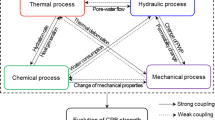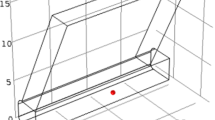Abstract
Cemented paste backfill (CPB, a mixture of tailings, water and binder) is widely utilized to fill underground mine voids. To achieve a good, economical performance, one approach is to proportionally use mineral admixtures such as fly ash and slag as partial substitutes for Portland cement. Binder hydration is one of the most significant factors that can generate heat within hydrating CPB structures, which in turn, influences the mechanical and hydraulic properties of CPB, as well as the pore structure within CPB. However, the temperature evolution due to the hydration of Portland cement that contains fly ash or slag is different from that of hydration with solely Portland cement. Hence, in consideration of the heat generated by both binder hydration and transferred between CPB and its surrounding media, a numerical model is developed to predict and determine the temperature development within CPB that contains mineral admixtures. After that, data from field and laboratory studies are employed to validate the developed model. The validation results demonstrate a good consistency between the model and the field and laboratory studies. Consequently, the proposed model is applied to simulate and determine the temperature evolution with time via mineral admixtures, binder content, initial rock and CPB temperatures, stope geometry, backfilling rate, curing time and backfilling strategy. The obtained results will contribute to better designs and preparation of CPB mixtures, as well as predict the temperature distribution within CPB structures.























Similar content being viewed by others
References
Abdul-Hussian N, Fall M (2011) Unsaturated hydraulic properties of cemented tailings backfill that contains sodium silicate. Eng Geol 123(4):288–301
Alnajim A (2004) Modélisation et simulation du comportement du béton sous hautes températures par une approche thermo-hygro-mécanique couplée. Application à des situations accidentelles, PhD thesis, Université Marne La Vallée
Baggio P, Bonacina C, Schrefler BA (1997) Some consideration on modelling heat and mass transfer in porous media. Transp Porous Media 28(3):233–251
Bary B, Sellier A (2004) Coupled moisture-carbon dioxide-calcium transfer model for carbonation of concrete. Cem Concr Res 34(10):1859–1872
Bloss M (2002) Below ground disposal (mine backfill). In Paste and Thichened Tailings: a guide, ed. Jewell, Fourie and Lord, University of Western Australia, pp 103–126
Bourgeois F, Burlion N, Shao JF (2002) Modelling of elastoplastic damage in concrete due to desiccation shrinkage. Int J Numer Anal Methods Geomech 26(8):759–774
Brakebusch FW (1994) Basics of paste backfill systems. Min Eng 46:1175–1778
Buffo-Lacarriere L, Sellier A, Escadeillas G, Turatsinze A (2007) Multiphasic finite element modeling of concrete hydration. Cem Concr Res 37(2):131–138
Celestin JC, Fall M (2008) Thermal conductivity of cemented paste backfill materials and factors affecting it. Min Reclam Environ 23(4):1–17
COMSOL AB (2005) COMSOL Multiphysics User’s Guide. Available from http://www.comsol.com/
D’Aloia L, Chanvillard G (2002) Determining the “apparent” activation energy of concrete: Ea-numerical simulations of the heat of hydration of cement. Cem Concr Res 32(8):1277–1289
De Souza E, Hewitt A (2005) The Contribution of Cemented Backfill to Heat Loads. In: 8th International Mine Ventilation Congress. Brisbane, pp 87–93
Fall M, Benzaazoua M (2005) Modeling the effect of sulphate on strength development of paste backfill and binder mixture optimization. Cem Concr Res 35(2):301–314
Fall M, Samb SS (2006) Influence of curing temperature on strength, deformation behaviour and pore structure of cemented paste backfill at early ages. Constr Build Mater
Fall M, Samb SS (2007) Pore structure of cemented tailings materials under natural or accidental thermal loads. Mater Charact 59(5):598–605
Fall M, Benzaazoua M, Ouellet S (2005) Experimental characterization of the influence of tailings fineness and density on the quality of cemented paste backfill. Miner Eng 18(1):41–44
Fall M, Nasir O, Celestin JC (2007) Paste backfill responses in deep mine temperature conditions. In: 9th International Symposium of mining with backfill. Montreal, Canada, CD-Rom
Fall M, Benzaazoua M, Sae E (2008) Mix proportioning of underground cemented paste backfill. Tunn Undergr Space Technol 23(1):80–90
Fall M, Adrien D, Celestin JC, Pokharel M, Toure M (2009) Saturated hydraulic conductivity of cemented paste backfill. Miner Eng 22(15):1307–1317
Fall M, Celestin JC, Pokharel M, Touré M (2010) A contribution to understanding the effects of curing temperature on the mechanical properties of mine cemented tailings backfill. Eng Geol 114(3–4):397–413
Grice T (2001) Recent mine developments in Australia. Proceeding of the 7th international symposium on mining with backfill (MINEFILL), pp 351–357
Hansen PF, Pedersen EJ (1977) Maturity computer for controlled curing and hardening of concrete. Nordisk Betong 1:21–25
Jonasson JE, Groth P, Hedlund H (1995) Modeling of temperature and moisture field in concrete to study early age movements as a basis for stress analysis. In: Proceedings of the International RILEM Symposium on Thermal Cracking in Concrete at Early Ages. London, pp 45–52
Kesimal A, Ercikdi B, Yilmaz E (2003) The effect of desliming by sedimentation on paste backfill performance. J Min Eng 16:1009–1011
Kesimal A, Yilmaz E, Ercikdi B, Deveci H (2005) Effect of properties of tailings and binder on the short-and long-term strength and stability of cemented paste backfill. Mater Lett 59:3703–3709
Kim JK, Han SH, Lee KM (2001) Estimation of compressive strength by a new apparent activation energy function. Cem Concr Res 31(2):217–225
Kim KH, Jeon SE, Kim JK, Yang S (2003) An experimental study on thermal conductivity of concrete. Cem Concr Res 33(3):363–371
Kjellsen KO, Detwiler RJ, Gjørv OE (1991) Development of microstructure in plain cement pastes hydrated at different temperatures. Cem Concr Res 21(1):179–189
Krus M, Hansen KK, Kiinzel HM (1997) Porosity and liquid absorption of cement paste. Mater Struct 30(7):394–398
Landriault D (1995) Paste backfill mix design for Canadian underground hard rock mining. 97th Annual General Meeting of CIM. Rock Mechanics and Strata Control Session. Halifax, Nova Scotia, pp 229–238
Lerche R, Renetzeder H (1984) Development of pumped fill at Grund Mine, Preussag AG Metall. In: Proceedings of the 9th International Conference on the Hydraulic Transport of Solids in Pipes, Rome, Italy, p 24
Luckner L, van Genuchyen MTH, Nielsen DR (1989) A consistent set of parametric models for the two-phase flow of immiscible fluids in the subsurface. Water Resour Res 25(10):2187–2193
Maekawa K, Ishida T (2002) Modeling of structural performances under coupled environmental and weather actions. Mater Struct 35(10):591–602
Maekawa K, Chaube R, Kishi T (1999) Modeling of Concrete Performance: Hydration. Microstructure Formation and Mass Transport, E&FN SPON, London
Mainguy M, Coussy O, Baroghel-Bouny V (2001) Role of air pressure in drying of weakly permeable materials. J Eng Mech 127(6):582–592
Meschke G, Grasberger S (2003) Numerical modeling of coupled hygromechanical degradation of cementitious materials. J Eng Mech 129(4):383–392
Mills RH (1966) Factors influencing cessation of hydration in water cured cement Pastes. Highway Research Board Special Report 90:406–424
Morabito P (1989) Measurement of thermal properties of different concretes, High Temperatures. High Press 21(1):51–59
Mualem Y (1976) A new model for predicting the hydraulic conductivity of unsaturated porous media. Water Resour Res 12:513–522
Nasir O, Fall M (2009) Modeling the heat development in hydrating CPB structures. Comput Geotech 36(7):1207–1218
Nasir O, Fall M (2010) Coupling binder hydration, temperature and compressive strength development of underground cemented paste backfill at early ages. Tunn Undergr Space Technol 25(1):9–20
Pokharel M (2008) Geotechnical and environmental response of paste tailings systems to coupled thermo-chemical loadings. Master Thesis (M.A.Sc.), University of Ottawa, p 248
Poyet S, Charlesa S, Honoré N, L’hostisa V (2011) Assessment of the unsaturated water transport properties of an old concrete: Determination of the pore-interaction factor. Cem Concr Res 41(10):1015–1023
Richards LA (1931) Capillary conduction of liquids through porous mediums. Physics 1(5):318–333
Savage BM, Janssen DJ (1997) Soil physics principles validated for use in predicting unsaturated moisture movement in Portland cement concrete. ACI Mater J 94(1):63–70
Schindler AK (2004) Effect of temperature on the hydration of cementitious materials. ACI Mater J 101(1):72–81
Schindler AK, Folliard KJ (2003) Influence of supplementary cementing materials on the heat of hydration of concrete. In: 9th Conference on Advances in Cement and Concrete. Colorado
Schindler AK, Folliard KJ (2005) Heat of hydration models for cementitious materials. ACI Mater J 102(1):24–33
Sivakugan N, Rankine KJ, Rankin KS (2005) Geotechnical consideration in mine backfilling in Australia. J Clean Product 14(12–13):1168–1175
Somerton WH, Keese JA, Chu SL (1974) Thermal behaviour of unconsolidated oil sands. Soc Petroleum Eng 14(5):513–521
Talor SC, Hoff WD, Wilson MA, Green KM (1999) Anomalous water transport properties of Portland and blended cement-based materials. J Mater Sci Lett 18(23):1925–1927
Thomas HR, Sansom MR (1995) Fully coupled analysis of heat, moisture and air transfer in unsaturated soil. J Eng Mech 121(3):392–405
Thompson BD, Grabinsky MW, Bawden WF, Counter DB (2009). In situ measurements of cemented paste backfill in long-hole stopes. In: Proceedings of the 3rd Canada–US Rock Mechanics Symposium and 20th Canadian Rock Mechanics Symposium (RockEng09). Toronto
Tong F, Jing L, Zimmerman RW (2010) A fully coupled thermo-hydro-mechanical model for simulating multiphase flow, deformation and heat transfer in buffer material and rock masses. Int J Rock Mech Min Sci 47(2):205–217
van Genuchten MTH (1980) A closed-form equation for predicting the hydraulic conductivity of unsaturated soils. Soil Sci Soc Am J 44(5):892–898
Wang CY, Beckermann C (1993) A two-phase mixture model of liquid-gas flow and heat transfer in capillary porous media-I. Formulation. Heat Mass Transf 36(11):2747–2758
Wang XY, Lee HS (2010) Modeling the hydration of concrete incorporating FA or slag. Cem Concr Res 40(7):984–996
Williams TJ, Denton DK, Larson MK, Rains RL, Seymour JB, Tesarik DR (2001) Geomechanics of reinforced cemented backfill in an underhand stope at the Lucky Friday Mine, Mullan, Idaho. US Department of Health and Human Services
Yilmaz E, Kesimal A, Ercidi B (2004) Strength development of paste backfill simples at Long term using different binders. In: Proceedings of 8th symposium MineFill04, China, pp 281–285
Author information
Authors and Affiliations
Corresponding author
Rights and permissions
About this article
Cite this article
Wu, D., Fall, M. & Cai, Sj. Coupled Modeling of Temperature Distribution and Evolution in Cemented Tailings Backfill Structures that Contain Mineral Admixtures. Geotech Geol Eng 30, 935–961 (2012). https://doi.org/10.1007/s10706-012-9518-1
Received:
Accepted:
Published:
Issue Date:
DOI: https://doi.org/10.1007/s10706-012-9518-1




